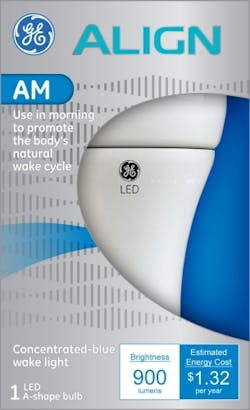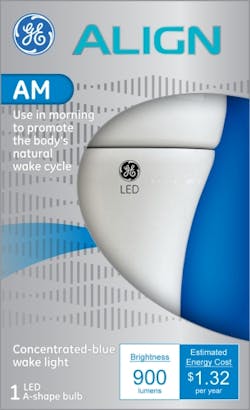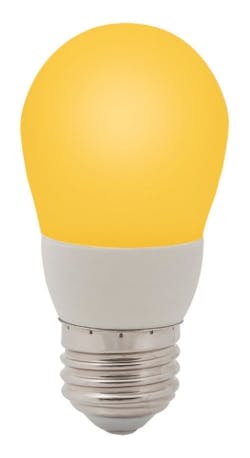GE Align SSL retrofit lamp technology aims to nurture the natural human sleep and wake cycles, while the Lighting Science Group Sleepy Baby product is designed for infant sleep training.
GE Lighting and the Lighting Science Group (LSG) each have new LED-based, retrofit-lamp products intended to help humans sleep properly. GE's new Align family includes different versions intended for night and morning usage. Lighting Science Group has been selling similarly-intended Good Night and Awake & Alert lamps and has now added Sleepy Baby lamps designed to assist parents in training infants to sleep through the night.
It is fairly well established that warm-CCT light at night encourages melatonin production in humans and induces sleep and a restful night. Likewise, blue-rich cooler-CCT lighting in the morning can suppress melatonin and lead to alertness and increased productivity. Philips was involved in one such study on LED lighting and human circadian rhythms. Researchers still don't fully understand the impact of lighting on non-visual receptors in humans, as we covered in a recent interview. Still, many companies are ready to move forward with solid-state lighting (SSL) technology intended to optimize sleep/wake cycles.
Many of the products being developed for matching the circadian cycle use tunable light engines to produce the warm and cool light at different times of the day and night. But such designs inevitably cost more because multiple channels of LEDs are involved, a more complex driver is required, and a control element must be included for either autonomous or programmatic control of the lamps or luminaires.
GE Align lamps
The products we cover here including the GE Align lamps take a more simplistic approach to circadian lighting. GE is offering two separate LED retrofit lamps for night and morning usage. The Align PM bulbs produce an amber hue meant to mimic candlelight or fire. GE recommends that people use the 7W lamps that produce 350 lm for 30 minutes prior to bedtime.
The 11W Align AM lamp produces 900 lm in a hue that GE describes as "concentrated bluish-white light. The company says that 30 minutes of usage after waking helps promote the natural wake cycle. The lamps are each listed at $35, although amazon.com has the PM version for $31.09 and the AM version for $32.48 currently.
"Aren’t we all tuned to the good feelings on a bright and sunny day, or the feelings we have on a gloomy day? Light impacts not only our mood and wellness, but our ability to fall asleep," said Gary Allen, physicist and LED innovations principal engineer at GE Lighting. "By changing the timing, amount, spectral quality of light exposure, we can avoid disrupting the body’s natural circadian rhythms."
GE has also produced a lengthy whitepaper on lighting and sleep. The nine-page PDF document includes a characterization of our current base of knowledge on the circadian rhythm, melatonin production, and the sleep/wake cycle. Perhaps more significantly, the document includes a comprehensive set of references to research in the area.
LSG circadian lamps
Of course, the GE lamps were not the first such products to market. LSG had announced the Good Night and Awake & Alert lamps at the Consumer Electronics Show (CES) back in January 2014. At the time, LSG said the consumer products were based on what it had learned in working with astronauts that had visited the International Space Station who depend completely on artificial light.
Now LSG has released the Sleepy Baby lamp designed for use by parents during an infant's nightly bedtime routine. The 3.5W retrofit lamp produces 300 lm and is designed to replace a 40W incandescent bulb. The product has a very-warm 2300K CCT and is rated for 25,000 hours of use. It sells for $30 and comes with a five-year warranty.
"As a scientist, and the father of an infant myself, it was important to me to develop a biologically-correct LED lamp that could benefit my family," said Robert Soler, director of lighting research at Lighting Science Group. "Utilizing the ground-breaking, collaborative research we did with NASA for our Good Night LED lamps, we biologically tailored it to work to support healthy infant circadian rhythm development and sleep cycles. Your baby can now utilize our light to fall asleep faster; stay asleep longer; and fall back to sleep quicker if awakened for late night feedings or changings. This product takes full circle Lighting Science’s dedication to provide healthy LED lighting and promote the advancement of biological lighting in the global environment."







